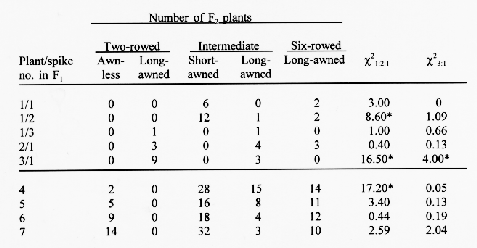

In crosses of a sex-rowed line (vv) with a two-rowed variety (VV), aberrant ratios were found in the kernel row number and the fertility of lateral floerts, which are controlled by an incompletely dominant gene. To test the reason for this instability, further crosses involved the dominant gene Lk which suppresses the development of awns on the lemma and is linked completely to the v locus in chromosome 2 (Nilan, 1964).
Ths six-rowed, awned Line 152 (vv, lklk) originated from the Dornburg mutant collection (Hentrich, 1964) and the two-rowed, anless Ethiopian barleys E.P. 79 and HOR 2937 (VV, LkLk) obtained from teh Gatersleben World Collection were crossed. The F1 was swon in January in pots in a glasshous without iluumination under cool condition, and the F2 in March in a foliage house. Single ripe plants were harvested, and the types of spikes and awns were classified.
Results
The F1 of the cross of two-rowed, awnless barleys (VV, LKLK) with six-rowed, awned ones (vvlklk) commonly had intermediate, short-awned spikes (Vv, Lklk). However, when the Ethiopian barleys were crossed with the Line 152, three exceptional F1 plants (6.1%) carrying medium length to long awns were also found. One of them was a chimeric plant having two intermediate, short-awned spikes (No. 1/1 and 1/2) and a two-rowed, long-awned one (No. 1/3). Table 1 shows the segregation of single spike progenies of this chimera, the other two exceptional plants (No. 2/1 and 3/1), and ratios of progenies from normal Fl plants (No. 4 to 7). In the progenies of the exceptional spikes, the parent type 1 (VV, LkLk) is absent, but the recombinant type (VV, Iklk) appears frequently.
Discussion
Because the functional genes v and Ik are very closely linked, three phenotypic classes of progeny are expected in the F2. The ratio is 1/4 two-rowed, awnless; 1/2 intermediate, shortawned; and 1/4 six-rowed, long-awned plants. The surprising occurrence of one recombinant type only indicates non-reciprocal recombination at the v-lk region. Such events, termed gene conversion, were first discovered and well documented hitherto in the fungi (see Catcheside, 1977). The appearance of the recombinant, long-awned phenotype in the F1 and in the intermediate class in the F2 suggests that the conversion of the genes Lk into Ik and v into V, respectively, occurs in somatic cell divisions of heterozygote plants. The chimeric nature of several plants, which probably also causes the aberrant ratios, supports this assumption. The occurrence of these events needs a high frequency of mitotic chromosome pairing, which is likely promoted by crosses with Line 152, and seems to be also influenced by growing conditions.
In conclusion, the Lk-V genetic system provides an opportunity to investigate frequencies of non-reciprocal events, their dependence on genetic and ecological factors, and their implication in plant breeding.

References
Catcheside, D. 1977. The Genetics of Recombination. Arnold, London.
Hentrich, W. 1964. Atompraxis 10:315-320.
Nilan. R. A. 1964. Res. Stud. Washington St. Univ. 32(1), Monogr. Suppl. 3.